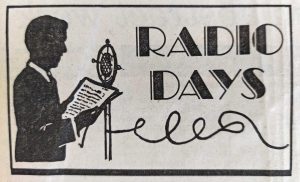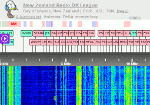
When Telecom unearthed its files on early private radio stations in Otago, it came up with more than dust and cobwebs. Radio New Zealand historian JIM SULLIVAN recounts the “fascinating stories” of the province’s radio station in the 1930s.
DUNEDIN was New Zealand’s “radio capital” in the early 1930s as it boasted more radio stations than any other city. Public radio was administered by the Broadcasting Board in Wellington and it had two Dunedin stations 4YA and 4YO.
But private radio had always been strong in Dunedin, and in 1933 local private stations included 4ZB, 4ZF, 4ZL, 4ZM, 4ZO and 4ZW. Balclutha had 4ZR and, at Lowburn Ferry, young John Bilton was running 4ZC, Cromwell. A total of 10 Otago stations – Wellington could muster only 3.
These private stations were licensed each year for a fee of two pounds two shillings and sixpence. They were checked monthly by the Post Office district engineer.
Telecom’s files on these early stations tell some fascinating stories. The file for 4ZC, Cromwell includes a petition asking for financial help for the station. It is signed by 120 Cromwellians, including a newspaper proprietor, two bootmakers and two blacksmiths.
“How the Post Office hounded these noble stations.” They were being continually reminded not to “solicit” on air, to keep to their agreed hour, never to advertise, and to avoid at all costs “Americanisms like “theatre of the air” or “here it is!.”
A blast was received by 4ZM for charging two and six for a lost dog announcement.
“Engineers are tough censors.” The 4ZW story stands out. It is one of frustration, financial woe, bureaucratic wrangles, technical problems and a touch of human tragedy.
Adam Clarke started it off by buying the plant of 2ZR Wanganui, in 1931. He applied for a licence, paid over his money and went on the air with the help of a pioneer radio operator Norman Arundel. Within a year he had moved to new premises at Arthur Barnett’s store. Rival operators McCracken and Walls offered to buy him out, but negotiations were not smooth and in the end Clarke survived by refusing to let the licence document out of his hands.
Most stations had an interest in local electrical firms who were intent on pushing the sales of radio sets.
In 1935 4ZO Dunedin offered to move to Wellington to boost the capital’s radio sales. Broadcasting Minister Fred Jones replied – “I will keep it in mind.”
Before long 4ZW, which had kept up a regular schedule in spite of technical problems, asked for permission to move to another building. A the same time Clarke’s firm, Radio Sales and Exchangers Ltd, was put in receivership and Clarke was told that the licence was no longer his – it was regarded as in the control of the receiver. Help was at hand, as his father’s firm bought the plant and Clark was permitted to carry on with 4ZW from the old Kings Theatre in Dowling Street.
By the end of 1932, things seemed to have settled down. Hours were extended and Clarke applied for a licence to broadcast in short-wave. (The Post Office refused, saying this was for international broadcasters only.)
“The Post Office, by the way, made a meal of paperwork.” All local requests were passed on to Wellington, it wrote back to Dunedin Post Office, which then wrote to the local station.
In 1933, Clarke took on local menswear retailer J. K. Woods as a partner and the plant was moved to Woods’s shop in George Street. Woods sold out in 1934 and Clarke moved 4ZW to Barton’s Buildings in Manse Street. (Retailers like Bartons, who were possibly Dunedin’s best known butchers, were only too happy to fit a radio station into their buildings as the station was able to announce “broadcasting from the Barton Building in Manse Street” – the closest to a commercial that was allowed.)
By 1934 Clarke was hauled over the coals for allowing a local tailor, H. L. Steedman, to give a talk on fashion. Apart from chastising people who wore regimental ties to which they were not entitled, Steedman urged his listeners to stick to tailor-made suits. At once local menswear shops (including Woods) bombarded the Post Office with complaints.
From then on all talks had to be approved before broadcast. This led to the unusual duty for a Post Office engineer of having to vet a talk en”Reincarnation.
Never to be down-hearted Clarke applied for permanent line to the Town Hall Concert Chamber, an expensive item at six pounds ten a year. Clarke also got a rocket for not having a proper telephone for the station. He seemed to have set up a sort of answering service with a nearby Subscriber.
By May, 1935, Bartons had decided they needed 4ZWs studio area and, on the first of the month. Clarke applied to move Howarth’s Radio Services in George Street.
That night the story of 4ZW came to a sad end as Adam Clarke died in his sleep.
His father sold the station licence, records and equipment to the Broadcasting Board for 135 pounds one and six. The unused portion of the licence was refunded and so ended the saga of 4ZW.
Those pioneering Otago radio stations all had a story to tell. Most were less dramatic that 4ZW’s, but in the end all were sold to the new Labour Government, except for 4ZB, which changed its call sign to 4XD and is on the air to this day while the 4ZB call sign lives on with Radio New Zealand’s community station.
‘How the Post Office Hounded those noble stations. They were told never to advertise’

Transcribed by Bill Marsh Jnr. Source of article unkown.



